Growing up, my least favorite chore was making the bed. Even if it only took 30 seconds, I would do anything to avoid tucking in my sheets or straightening my pillows.
Now that I’m older, I actually love a well-made bed. Getting ready to go to sleep, there’s nothing better than an inviting, organized bed. In my how to make a bed guide, I’ll go over all the components of a proper bed set and give you the inside tips for how to make and style your bed. Let’s get started!
How To Make Your Bed In The Morning
After you wake up and head to work, making your bed every day can set you up for success. There’s no one right way to make your bed but, depending on your schedule and style choices, I have a few great ways for you to make your bed in the morning.
Quick and Easy
If you’re in a hurry in the morning, you don’t need to overthink it. First off, clear your bed of everything but your fitted sheet. Next, make sure the fitted sheet lies flat across the mattress and is still completely tucked in.
Then, place your flat sheet across the bed with the design upside down. Make sure the flat sheet is hanging evenly off all four sides. Since you’re looking to do this quickly and easily, there is no need to tuck the flat sheet in at this point.
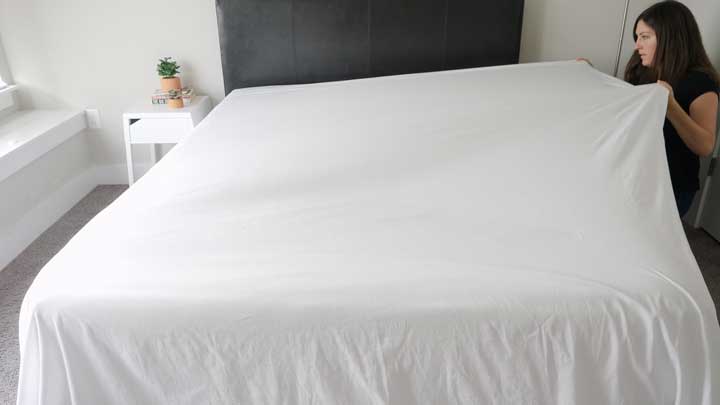
Next, lay your duvet or comforter evenly on top of the flat sheet. Don’t take the duvet or comforter all the way to the head of the bed. Leave a foot or so of space so you can fold the top of the sheet over the comforter. Remember when you put it upside down? Now, you’ll be seeing the design of the flat sheet right side up!
Finally, put your pillows in place, and you’re off to face the day!
Clean and Orderly
Some people prefer their bed to have a minimalist design. I will go into greater detail below, but a minimalist bed look usually only features a comforter or duvet, sheets, and sleeping pillows. If you like this clean, crisp look, you might want to consider making your bed with hospital corners.
Hospital corners are used in hospitals and the army as well. This style of bed-making keeps your sheets fit snugly on your bed, making it much more difficult to kick them off during the night. Hospital corners also leave your bed looking clean and organized during the day.
Here are some step-by-step instructions on how to make your bed with hospital corners. Don’t worry if this takes you a few tries to master. Pretty soon you’ll have the know-how to do this right!
Put your fitted sheet on your mattress. Make sure it is tight and lies flat across the bed. Then, drape your flat sheet across the mattress so that an even amount of fabric hangs off the left side, right side, and foot of the bed.
Starting at the foot of the bed, tuck the flat sheet under the mattress. Move to the left side of the bed and near the bottom corner, pull up the hanging sheet and lay it across the top of the bed at a 45-degree angle. Leave it there for now.
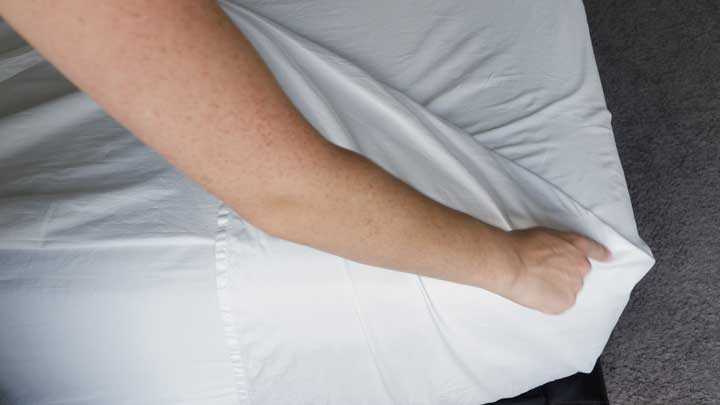
Then, take whatever sheet is still hanging off the bed and tuck it under the corner of the mattress. Now, go back up to the top of the mattress and fold that extra sheet back over the side of the bed. You’ll want to keep your hand across the side of the mattress so that the sheet folds over your hand. This will allow you to tightly fold the excess fabric under your mattress. You should see a diagonal line of sheet near the corner of the mattress. That is your hospital corner!
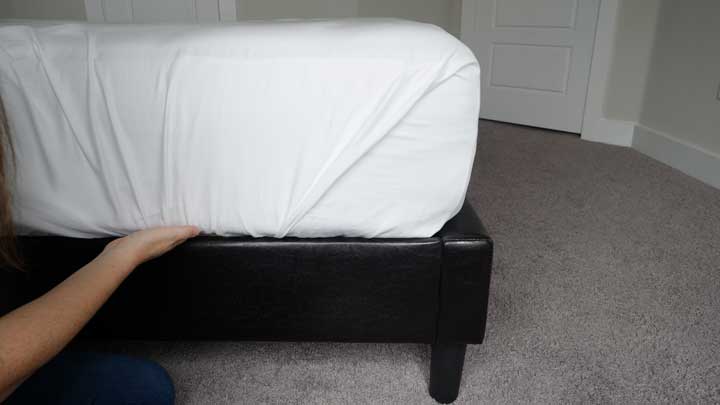
Repeat these steps on the bottom right corner of the mattress.
Again, this may seem confusing at first. For more detailed instructions and a helpful video, take a look at our full article on how to make hospital corners.
Professionally Luxurious
Do you want your bedroom to look like a luxury hotel room? Well, with a few easy steps, you could be sleeping like you’re on vacation every night. A hotel bed usually features a fitted sheet, flat sheet, comforter or duvet, large blanket, sleeping pillows, and accent pillows.
To make your bed hotel-style, first put on your fitted sheet and lay your flat sheet upside down across the bed. Next, lay your large blanket across the top of the mattress. Preferably, the blanket will be the same size as your sheets. Lay the blanket so it lines up with the flat sheet.
You can then fold the top foot or two of your flat sheet down so that you can now see the decorated side of the sheet. Again, that’s why we put it on upside down! You can then use our hospital corner tricks from above to tightly tuck in the sheet and blanket.
Then, it’s time to pull out your comforter! Fluff the comforter and lay it across the entire bed. You can then fold the top of the comforter down so that you can see the blanket and flat sheet. If you get cold during the night, you can pull the comforter up for more warmth. To add some more flair to the bed, many hotels will also place a throw blanket across the bottom of the bed.
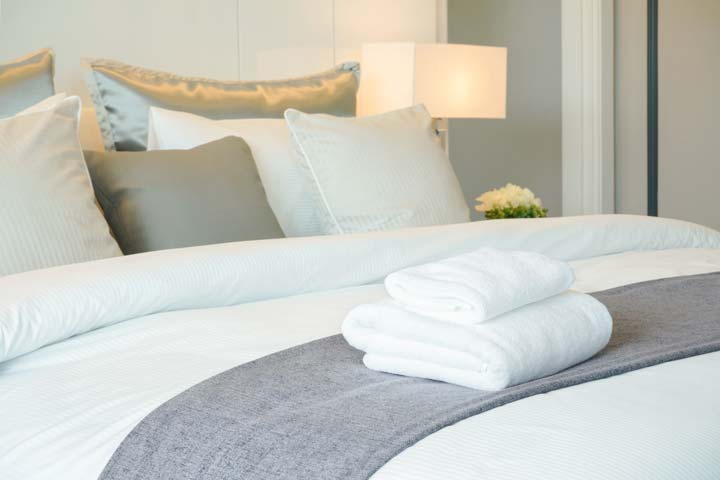
Most hotel beds boast a number of pillows, and you can do the same if you really like that luxurious look. There are so many ways to arrange your pillows, but here is how I personally like to create that hotel experience.
I first place two euro pillows against my wall or headboard. I stand them up instead of laying them flat. In front of that, I place my two sleeping pillows, also standing on end. Finally, I place a few accent pillows at the front. I personally don’t like a cluttered or busy-looking bed, so this is what I prefer. If you want some more great ways to arrange your pillows, check out our helpful guide.
How To Style Your Bed
We’ve gone over how to make your bed every morning. What if you really want to up the style of your bedroom? If you’re ready to let your inner interior designer out, here are a few ways to style your bed.
Minimalist
A minimalist-style bed doesn’t feature many components. If you sleep on a queen mattress, you’ll only need a fitted sheet, flat sheet, comforter or duvet, and two pillows.
You can make your bed with hospital corners or with the quick and easy method outlined above. You’ll want to stick to just the sheets, comforter, and pillows if you don’t like your bed to look too cluttered.
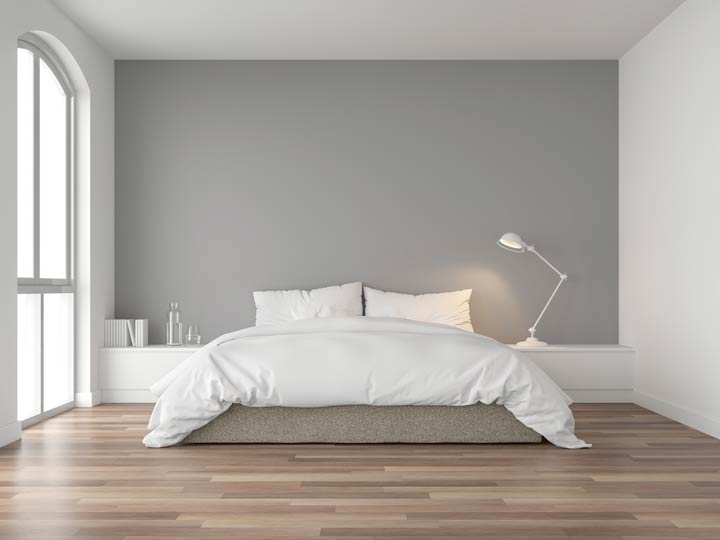
When it comes to choosing colors, the more neutral the better. A minimalist bed could be all white if you so choose. You could also layer in some grays, blues, and bedding with simple lines and stripes. You also don’t want too much texture in your pillow cases, comforter, or sheets. The less complicated the better!
Classic
A classically styled bed features a few more components than a minimalist bed. In addition to your fitted sheet, flat sheet, sleeping pillows, and comforter or duvet, you can add Euro pillows with pillow shams as well as a throw pillow and blanket.
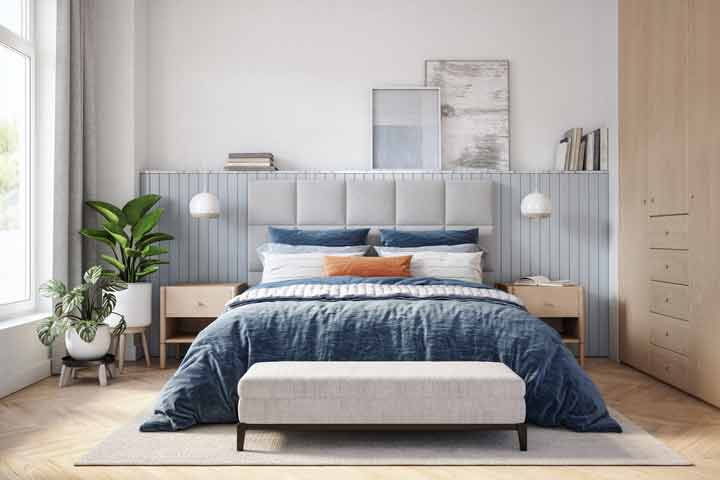
The color palette for most of your bedding should still be somewhat muted. Again, stick to your whites, grays, and blues. However, you can start to add in some more texture and accent colors. Your Euro pillows could feature shams with more texture, and your throw pillow and blanket could match your drapes or other bedroom elements.
Decorative Lux
If you’re vying for a spot on HGTV, the Decorative Lux style bed could be perfect for you. This style of bed should feature a fitted sheet, flat sheet, comforter or duvet, sleeping pillows, two Euro pillows with shams, several throw pillows, a blanket, and a bed skirt.
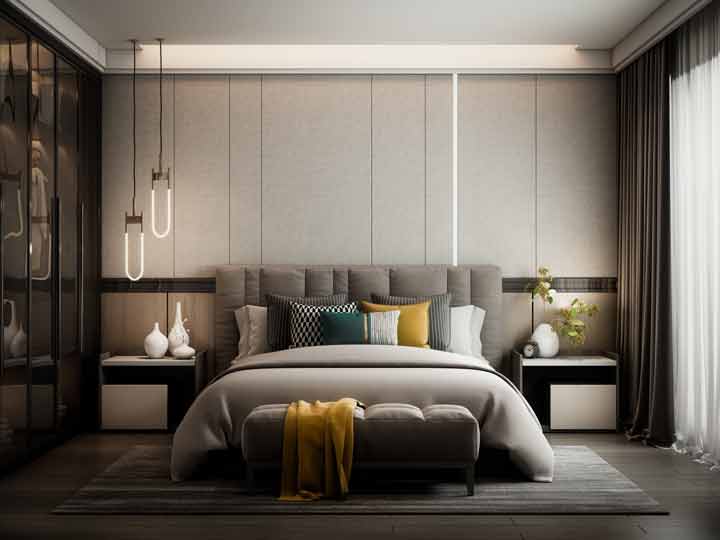
You’re adding a lot to your bed with this style, but don’t go overboard with the color. You’ll want to keep things as neutral as possible. The way to really add some flavor to this bed style is through texture. Choose some throw pillows with frills and fuzz. Take a look at a knit blanket to throw across the end of the bed. You’ll be able to feel the luxury!
How To Make A Bed: Breaking It Down Layer By Layer
What exactly makes up a complete bed set? Hint: It’s more than just pillows and sheets. Starting at the bottom, let’s look at each part of the perfect, stylish bed.
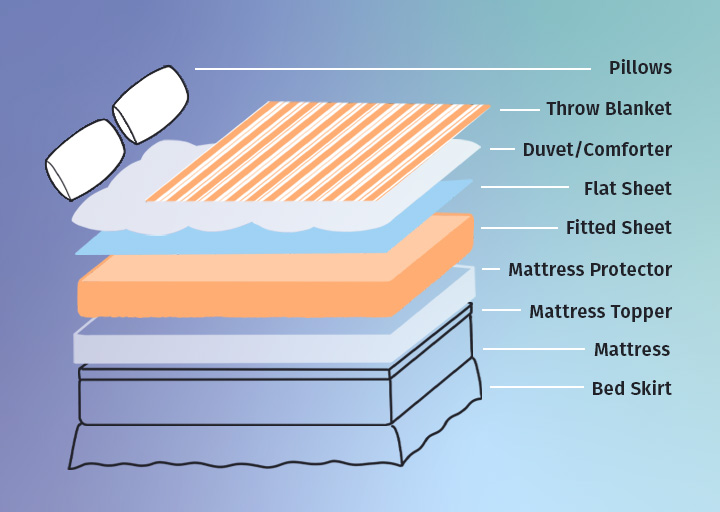
Pillows
Of course, how can we forget pillows? When it comes down to it, each person only needs one sleeping pillow. If you sleep with a partner, they should have their own pillow as well.
If you’re simply looking for a sleeping pillow, there are many kinds to choose from. Down or down alternative pillows are fluffy options that are also breathable and cooling. Memory foam pillows usually offer better support and give you that slow sinking-in feeling. If you like something bouncier and cooler, a latex pillow can be a great option. Take a look at our best pillow roundups to see which pillow is best for your situation.
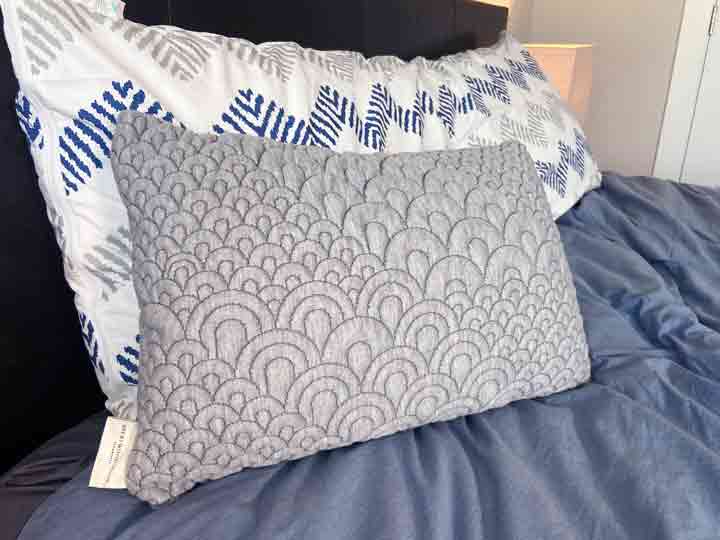
Pillows also have a stylistic function, and there are a few types of decorative pillows you can add to your bed. These are smaller than sleeping pillows and can help you boost the look and style of your bedroom.
- Euro pillows are square and are usually placed in a special cover called a sham. Depending on the design you are going for, a sham could be simple or complicated in its design.
- Throw pillows and accent pillows are smaller pillows that usually match the color of other elements in your bedroom such as the drapes or carpet.
- Bolster pillows are long, cylindrical, and usually stretch across the entire mattress. You can also use a bolster pillow to “bolster” support for other parts of your body.
If you want to know how many pillows you should sleep with, take a look at our guide.
Weighted Blankets or Throw Blankets
Weighted blankets and throw blankets are great therapeutic and stylistic additions to any bed set. A weighted blanket is designed to ease anxiety and even help you fall asleep more quickly. Weighted blankets apply deep pressure touch (DPT) which increases feelings of well-being and makes you feel less anxious and stressed. Consider adding a weighted blanket if you deal with anxiety, depression, ADHD, or restless leg syndrome.
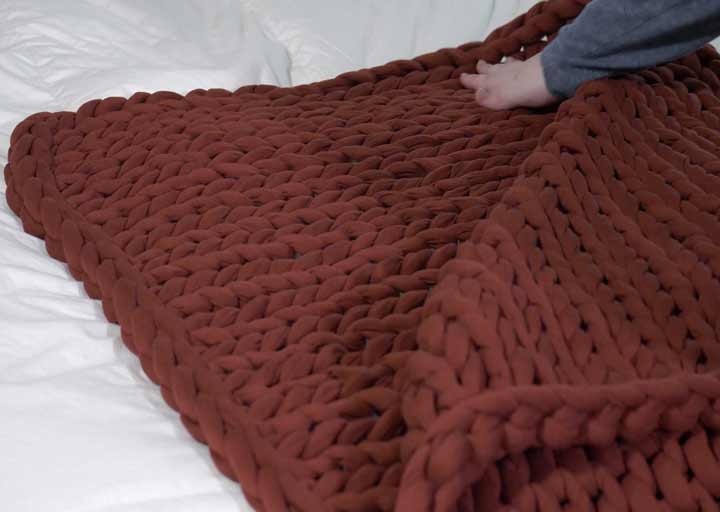
Throw blankets can add a little style and warmth to any bed. Draping a throw across your bed can add an accent color and help create an even more layered look. Throw blankets can also add a little warmth during the cooler months. You can keep a throw blanket folded across the bottom half of your mattress and simply pull it up if you get cold during the night!
Comforter or Duvet
Comforters and duvets are an important part of any complete bed set. First off, what is the difference between comforters and duvets? Well, many brands use these terms interchangeably, making it difficult to choose the right one!
Put simply, comforters are usually one piece of bedding filled with down or some type of down alternative. A duvet is two pieces – a duvet cover and a duvet insert. A duvet cover is basically a large pillow case for the duvet insert. A duvet insert could have the same design as a standard comforter or it could be a looser bag full of down or down alternative material.
A comforter could be preferable if you don’t want to deal with putting on a duvet cover or you just want a simpler design in your bedroom. A duvet will work better if you like to change the look of your bedroom often. For example, if you want to brighten up the overall design of your bed set, you can simply switch out your duvet cover, which is usually more affordable than buying a new comforter. A duvet cover is also much easier to clean than a comforter.
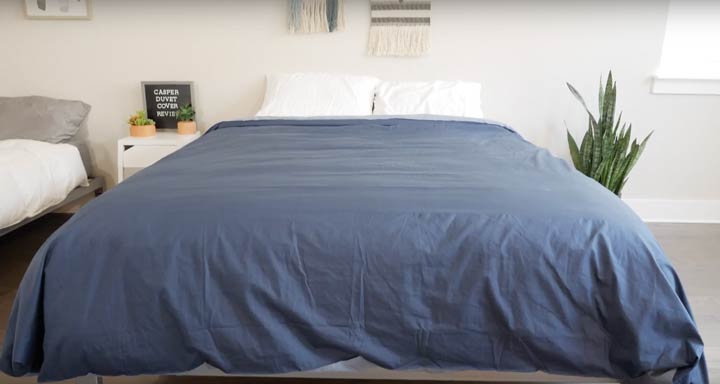
As I mentioned above, there are two major types of comforters – down and down alternative. Down comforters are usually more breathable and fluffy than down alternative comforters, but they are also more expensive. Down alternative comforters are more affordable, hypoallergenic, and will be a better option if you prefer to avoid animal products. Down comes from geese and ducks and some take issue with the way companies treat these animals.
If you would like a duvet set, there are a few types of materials to choose from. Similar to sheets, many duvet covers are available in sateen or percale. Depending on the feel or temperature you are looking for, sateen or percale could be better. If you live in a colder area, a flannel duvet cover could help keep you warm at night while also adding a comfortable, rustic look to your bedroom.
Putting your duvet or comforter onto the bed is easy. If you are working with a duvet, first make sure that the duvet insert isn’t clumped up inside. This can happen with duvet sets, but you can whip the duvet in the air or manually pull the insert to match the corners of the cover. When you place the duvet or comforter on the bed, make sure it hangs evenly off the sides of your bed. If you want a cleaner look, you can also tuck the hanging sides under your mattress.
Bed Sheets: Fitted and Flat
Sheets are a necessary part of any bed set. There are two types of sheet in any set – fitted and flat. Fitted sheets feature elastic around the edge and stretch directly across your mattress. Flat sheets, also known as top sheets, do not feature elastic and lie flat across your mattress. When you are sleeping, the fitted sheet will be beneath you, and the flat sheet will lie between you and your duvet or comforter.
While most sheet sets come with both a fitted and flat sheet, some sleepers may choose to forgo the flat sheet. They would rather sleep with their duvet or comforter right on top of them. This may make your bed style sleeker and more stylish, but it may not be the most hygienic. If you don’t use a flat sheet, you will need to wash your comforter or duvet more often. Also, a flat sheet should feel cooler and more breathable during the warmer months.
Sheets are also made of many types of materials, and these do have their upsides and downsides. Percale sheets are made of cotton and are crisp, durable, and breathable. However, these cotton sheets do wrinkle more easily, don’t keep you as warm, and aren’t as soft to the touch. Sateen sheets are also made from cotton, but their weave makes them softer, warmer, and shinier. The downside to sateen sheets is that they aren’t as durable as percale sheets and may not work as well for hot sleepers.
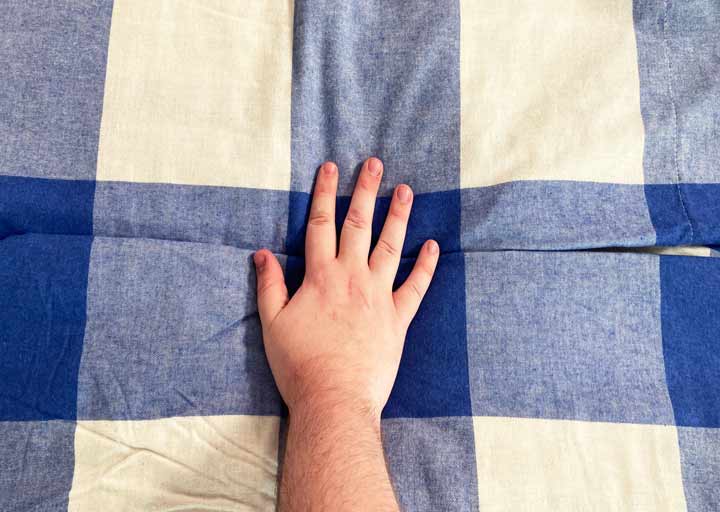
A few other types of sheets you may come across are flannel, supima, and linen. Read our Best Sheets guide to find out more about these different kinds of sheets.
No matter what type of sheets you get, here’s a great step-by-step guide for how to put your sheets on the bed and make them look as crisp and nice as possible.
- Stretch one corner of your fitted sheet over the corresponding corner of the bed. Make sure you tuck the fabric completely under the corner so that it does not come loose. Just note that if you are using a mattress topper, this may be more difficult.
- Do the same with the opposite corner of the sheet. For example, if you first covered the top left corner, you should now stretch the sheet over the bottom right corner.
- Then, work your way around the mattress, pulling the sheet corners over the remaining mattress corners.
- Tuck excess sheet fabric under the mattress so that the fitted sheet is stretched completely flat across your mattress.
- Lay your flat sheet on top of the fitted sheet so that it lines up with the top edge of the mattress. Tuck the bottom of the sheet under the mattress and then work your way around the bed.
Mattress Protector
While you can’t necessarily see a mattress protector on a fully-made bed, it is still very useful. As the name suggests, a mattress protector protects your mattress from spills, messes, mold, mildew, and even bed bugs. Also, while you sleep, your body sweats, sheds hair, and sloughs off dead skin. Without a protector, your mattress absorbs all of this!
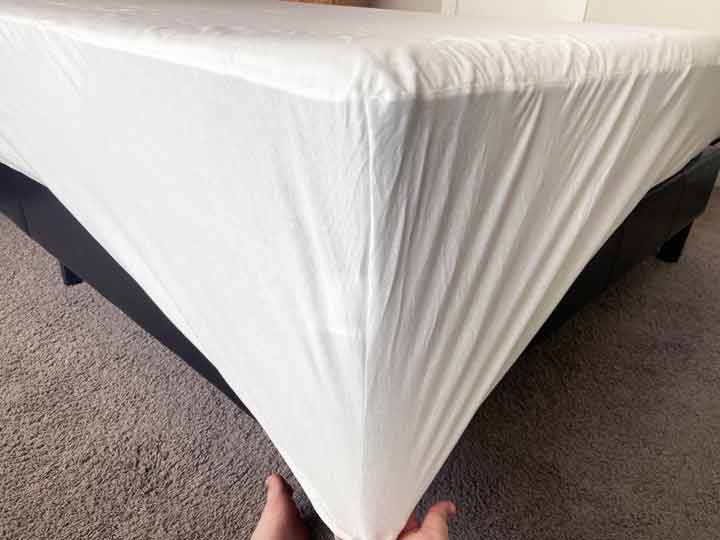
To put on a mattress protector:
- Ensure that your mattress is free of bedding and pillows.
- Unfold your mattress protector across the surface of your mattress.
- Match up the corners of the protector with your mattress and pull them down. The mattress protector will stretch like a fitted sheet.
- Make sure to tuck any extra fabric under the mattress so that the protector fits snugly across the top.
RELATED: Do You Need A Mattress Protector?
Mattress Topper
Like a bed skirt, a mattress topper isn’t necessary for every type of bed or sleeper. However, if your mattress is too firm and isn’t offering you enough comfort, a mattress topper could be a worthy addition.
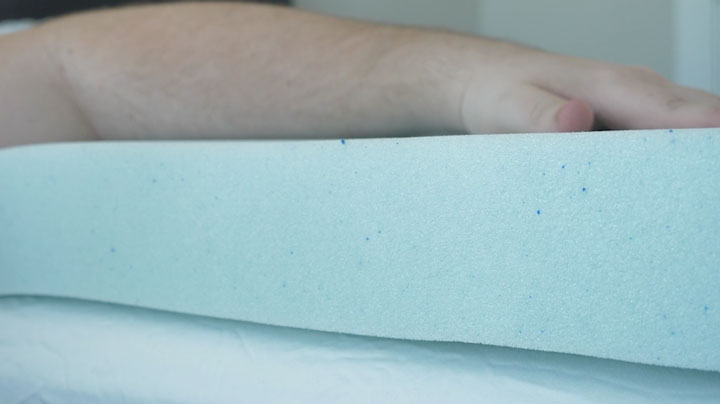
Mattress toppers are usually made of some type of memory foam or polyfoam. Depending on their thickness, they can add additional softness to your mattress. For example, a 4” memory foam topper is going to be much softer than a 2” memory foam topper. If you want very little added comfort, you could also consider a mattress pad.
Mattress toppers can also help cool down your mattress if sleeping hot is an issue. Latex foam toppers and foam toppers with cooling infusions can help lower your temperature during the night.
Whether your mattress is too firm or too hot, a mattress topper is a more budget-friendly alternative to buying an entirely new mattress.
Bed Skirt
The last part of a fully furnished bed is the bed skirt. If you’ve ever stayed at a nice hotel, you might have noticed a bed skirt hanging from the bed frame down to the floor.
A bed skirt has a stylistic purpose in that it can match the color of your bedding and create a clean, unified look. It can also be useful in hiding clutter or anything else you may keep under the bed.
At the same time, bed skirts will add some cost to your bed set, and they may not be pet-friendly. Unfortunately, bed skirts can attract pet hair and fur. Some people complain of “hairy skirts” which are unseemly. You can actually combat this issue by buying a bed skirt that matches the color of your pet!
FAQs
How can I make my sheets stay in one place?
There are a few ways to make your sheets stay in one place. You could tuck the sheets in using the hotel corner technique. This style of tucking in your sheets will keep you from kicking them off during the night. You could also use products like sheet suspenders or non-slip rug corners.
Where do I put a throw blanket on a bed?
You should put your throw blanket across the bottom part of your bed. It can go as high as halfway up the bed or down at the very bottom of your bed. Both of these styles put the throw within reach if you get cold during the night.
How do I make a bed hotel style?
To make your bed hotel style, layer a thin blanket over your flat sheet and fitted sheet. Turn the flat sheet and blanket down a foot or so. Then, tuck the flat sheet and blanket in hospital style. Next, layer your comforter or duvet across the entire mattress and then turn it down to nearly halfway down the mattress. Finally, add your sleeping pillows and decorative pillows.
How do I make a bed military style?
To make your bed military style, first place your fitted sheet snugly on the mattress. Then, drape the flat sheet across the bed so it hangs evenly off the left, right, and bottom of the mattress. Next, tuck the flat sheet under the foot of the mattress, making sure it is tight.
You will then move to the left side of the mattress and, a few inches from the foot of the mattress, pull up the flat sheet and lay it across the top of the mattress at a 45 degree angle. Whatever is left hanging off the side of the mattress you will tuck under the corner of the mattress. Then, bring the sheet you have laid across the bed back down over the side. Keep your hand against the side of the mattress so that you create a crisp fold.
Keeping everything tight against the mattress, tuck the rest of the fabric under the mattress. You should see a diagonal fold leading up to the corner of the mattress.

